Trogir is one of the most seductive towns on the Dalmatian coast, a compact brown-beige welter of places, jutting belfries ad shambling streets fanning out from an antique central square. Trogir is tiny, medieval-architecture-packed town surrounded by water. Founded by Greeks from Vis in the third century BC, Trogir can compare with any of the towns on the coast in terms of historic sights, and its cathedral is one of the finest in the Adriatic. Trogir is a remarkable example of urban continuity. The orthogonal street plan of this island settlement dates back to the Hellenistic period and it was embellished by successive rulers with many fine public and domestic buildings and fortifications. Its beautiful Romanesque churches are complemented by the outstanding Renaissance and Baroque buildings from the Venetian period.
General facts about Trogir city
 Trogir is a historic town with harbour on the Adriatic coast in the Split-Dalmatia County in Croatia. Its has population of 10,818 and a total municipality population of 13,260. The historic city Trogir is situated on a small island between the Croatian mainland and the island of Ciovo. It is situated 27 kilometres (17 miles) to the West from the Split. Since 1997, the historic centre of Trogir entered the UNESCO’s list of World Heritage Sites. In the III century B.C, Greek colonists from the Vis island founded Tragurion. It was a major port until the Roman period. The name originates from the Greek “tragos” (male goat). Similarly, the name of the neighboring island Bua originates from the Greek “voua” (herd of cattle). The sudden prosperity of Salona deprived Trogir of its importance. During the Slavs migration, citizens of destroyed Salona escaped to Trogir. From the IX century, Trogir paid tribute to Croatian rulers.
Trogir is a historic town with harbour on the Adriatic coast in the Split-Dalmatia County in Croatia. Its has population of 10,818 and a total municipality population of 13,260. The historic city Trogir is situated on a small island between the Croatian mainland and the island of Ciovo. It is situated 27 kilometres (17 miles) to the West from the Split. Since 1997, the historic centre of Trogir entered the UNESCO’s list of World Heritage Sites. In the III century B.C, Greek colonists from the Vis island founded Tragurion. It was a major port until the Roman period. The name originates from the Greek “tragos” (male goat). Similarly, the name of the neighboring island Bua originates from the Greek “voua” (herd of cattle). The sudden prosperity of Salona deprived Trogir of its importance. During the Slavs migration, citizens of destroyed Salona escaped to Trogir. From the IX century, Trogir paid tribute to Croatian rulers.
The diocese of Trogir was established in the XI century (and abolished in 1828; it is now part of the Roman Catholic Archdiocese of Split-Makarska). In 1107, it was chartered by the Hungarian-Croatian king Coloman, thus gaining its autonomy as a town. In 1123, Saracens conquered and almost completely demolished Trogir. However, Trogir recovered in a short time and powerful economic prosperity in the XII and the XIII century followed. As he fled from Tatars in 1242, king Bela IV found refuge in this town. In the XIII and the XIV century, members of the Subic family were most frequently elected as dukes by the citizens of Trogir; Mladen III (1348.), according to the inscription on the sepulchral slab in the Cathedral of St. Lawrence called “The Shield of the Croats”, was one of the most prominent Subics. In Dalmatia, the city was known as Tragur.
Trogir has 2300 years of urban tradition. Its culture was created under the influence of the ancient Greeks, and afterwards the Romans and Venetians. Trogir has abundant variety of palaces, churches and towers, as well as a fortress on a small island. In 1997, it was included in the UNESCO’s World Heritage List. “The orthogonal street plan of this island settlement dates back to the Hellenistic period and it was embellished by successive rulers with many fine public and domestic buildings and fortifications. Its beautiful Romanesque churches are complemented by the outstanding Renaissance and Baroque buildings from the Venetian period”, said the UNESCO report. Trogir is the best preserved Romanesque-Gothic complex not only in the Adriatic, but in all of the Central Europe. Trogir’s Medieval city core, surrounded by walls, comprises a preserved castle, a tower and a series of houses and palaces from the Romanesque, Gothic, Renaissance and Baroque periods. Trogir’s grandest building is the Cathedral of St. Lawrence. Its main West portal is a masterpiece of Radovan, and the most significant work of the Romanesque-Gothic style in Croatia.
History of Trogir town
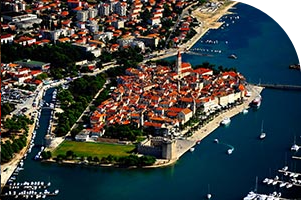 Trogir is an excellent example of a Medieval town. Conforming with the layout of a Hellenistic and Roman city it was built on, it has conserved its urban fabric to an exceptional degree and with the minimum of modern interventions. Trajectory of its social and cultural development is clearly visible in every aspect of the town scape. Trogir is a remarkable example of urban tradition. The orthogonal street plan of this island settlement dates back to the Hellenistic period and it was embellished by successive rulers with many fine public and domestic buildings and fortifications. Its beautiful Romanesque churches are complemented by the outstanding Renaissance and Baroque buildings from the Venetian period. Greek colonists from the Vis island in the III century B.C. founded the ancient town of Tragurion (Island of goats). It was a trading settlement located on an islet at the Western end of the Manios bay, in a strait between the mainland and one of the Adriatic islands, on a place of existing small settlement.
Trogir is an excellent example of a Medieval town. Conforming with the layout of a Hellenistic and Roman city it was built on, it has conserved its urban fabric to an exceptional degree and with the minimum of modern interventions. Trajectory of its social and cultural development is clearly visible in every aspect of the town scape. Trogir is a remarkable example of urban tradition. The orthogonal street plan of this island settlement dates back to the Hellenistic period and it was embellished by successive rulers with many fine public and domestic buildings and fortifications. Its beautiful Romanesque churches are complemented by the outstanding Renaissance and Baroque buildings from the Venetian period. Greek colonists from the Vis island in the III century B.C. founded the ancient town of Tragurion (Island of goats). It was a trading settlement located on an islet at the Western end of the Manios bay, in a strait between the mainland and one of the Adriatic islands, on a place of existing small settlement.
The Hellenistic town was enclosed by megalithic walls and its streets were laid out on a Hippodamian grid plan: the line of the ancient cardo maximus is that of the modern main street. The town flourished in the Roman period as an oppidum civium romanorum; during the late Roman period, it was extended and refortified. Extensive Roman cemeteries have been discovered, and a basilica was erected in one of them. Although it was not made a bishopric in the early Christian period, Trogir was endowed with two large aisled basilicas, sited where the latter-day Cathedral of St. Lawrence and Benedictine Church of St. John the Baptist now stand.
In the second half of the IX century, Trogir became part of the Byzantine theme of Dalmatia, with its capital Zadar, and it was occupied by Venice at the end of the X century. Early Medieval Trogir expanded to the South. New fortifications were constructed. At the beginning of the XII century, Trogir accepted Hungarian rule when the theme of Dalmatia was overrun. There was a short period of Venetian rule in the early XIV century, but it was not until 1420. that the town became part of the Venetian empire. Between the XIII and XV century, many new buildings were constructed. Among them were the Cathedral of St. Lawrence and the Kemerlengo Castle, a radical remodeling of the main square. There were also two campaigns of fortifications reconstruction and strengthening. The Treaty of Campo Formio (1797.) gave Trogir to the Austro-Hungarian Empire, to which it belonged until 1918, apart from a short period under French rule, as part of Illyrian provinces. Contemporary Trogir plan reflects the Hellenistic layout in the location, dimensions, and shapes of its residential blocks. The two ancient main streets, the cardo and the decumanus, are still in use, and paving of the forum has been located by excavation at their intersection.
Ancient Tragurion lies at the Eastern end of the islet; this spread out in the earlier Medieval period. The Medieval suburb of Pasike was spreading to the West on a different alignment and was enclosed by the later fortifications. The port was located on the Southern side. Finally, the massive Venetian fortifications incorporated the Genoese fortress known as the Kamerlengo Castle. Construction of the Cathedral of St. Lawrence, built on the site of an earlier basilica and dominating the main square, began approximately in 1200. and was continued in the late XVI century. This relatively protracted period of construction was a consequence of successive architectural styles – Romanesque, Gothic and Renaissance. It is a three-aisled basilica, each of the aisles terminating in an apse. Inside the porch at the West end is the baptistery. Of the numerous aristocratic palaces, the Cippico Palace, facing the West end of the cathedral, is the most outstanding one: complex of its structures is covering an entire town block. Most of it dates back to XIII century, with incorporated elements from the late Roman period. During XV century, the owner invited three most celebrated artists of the time to embellish its facade and interior. Scattered around the town and, in particular near the ramparts, there are palaces of other eminent families. Many of them were built on foundations of late Classical or Romanesque structures and their styles vary from Gothic to Baroque.
Sites in the city
The Kamerlengo Castle – Trogir’s fortifications are specific monuments, that gives the whole city a Medieval character. The small walls fragments are located in the Northern and the Western part of the city. The XIII century front South walls, as well as the Fort of St. Nicholas (kula sv. Nikole) and Fort Vitturi (kula Vitturi) have been well preserved. They have notable Romanesque characteristics – openings with sickle shaped arches and covered sentry walk along the walls. They are unique fortifications examples from those times. In the XIV century, the Genoese built a nine-sided tower in the Western corner of the city, a bit further from the old city core. It was supposed to be their navy base in the Adriatic. When the Venetians occupied Trogir in 1420, they combined this tower with the strong Kamerlengo fortress. It reveals the traces of construction stages. It was named after Kamerlengo (camerarius), the public servant, in charge of financial and economic affairs. After restoration and preservation, the fortress battlements and its top became accessible. They provide a stunning view of the city. This XIV century fortress was built for easier control of the harbor and the bay of Kastela. It is a most imposing fortress, that used to be connected to the city walls. It was built by the Genoans in the XIV century. In 1941, it was the place, where Fascist occupiers massacred locals. A memorial plaque notes that event.
 The Cathedral of St. Lawrence – is the town’s centerpiece, located on the main square. Built between the XIII and XVII century, the cathedral has a rich history. The bell tower alone took 200 years to build, thus becoming a textbook lesson of the Dalmatian architectural styles: Gothic at the bottom, Venetian Gothic in the middle and Renaissance at the top. The cathedral’s front entry – the ornately decorated, recently restored Radovan’s portal – is worth seeing. Inside, it’s dark, with many altars. The treasury features some beautiful XV century carved-wood cabinets, filled with ecclesiastical art and gear.
The Cathedral of St. Lawrence – is the town’s centerpiece, located on the main square. Built between the XIII and XVII century, the cathedral has a rich history. The bell tower alone took 200 years to build, thus becoming a textbook lesson of the Dalmatian architectural styles: Gothic at the bottom, Venetian Gothic in the middle and Renaissance at the top. The cathedral’s front entry – the ornately decorated, recently restored Radovan’s portal – is worth seeing. Inside, it’s dark, with many altars. The treasury features some beautiful XV century carved-wood cabinets, filled with ecclesiastical art and gear.
 Romanesque portal – the local architect and sculptor Master Radovan worked on cathedral’s gateway (main West portal) during early stages of its construction. Most of the portal was carved by the master himself, and some part by his pupils and followers. Finished and signed in 1240, it is a monumental and, perhaps, unique work of this great Croatian artist. Inscription in the base of the lunette is dedicated to him: The best of all in this artisanship. In terms of thematic concept, the portal is divided into two parts: upper and lower. The upper part shows scenes from the Gospels, that is, the life of the Christ. There is the scene of the Nativity on a lunette, and inside the arch above lunette, there are angels looking adoringly at the scene. The lunette and this arch are the work of Master Radovan. Above them, there is another arch with scenes from the life of Christ. On the interior of the doorposts, there are pictures of various works from different seasons. Radovan also worked on the two small columns covered in relief. The saints and apostles are pictured on the exterior doorpost, and the interior of the same doorpost is decorated with figures of exotic animals and fantastic creatures, like Centaurs and mermaids. Human forms dominate the portal. Both the internal and external doorposts rest on the back of bent over bearers, also the work of Radovan himself. Beside the portal, there are pictures of Adam and Eve standing on the backs of two lions.
Romanesque portal – the local architect and sculptor Master Radovan worked on cathedral’s gateway (main West portal) during early stages of its construction. Most of the portal was carved by the master himself, and some part by his pupils and followers. Finished and signed in 1240, it is a monumental and, perhaps, unique work of this great Croatian artist. Inscription in the base of the lunette is dedicated to him: The best of all in this artisanship. In terms of thematic concept, the portal is divided into two parts: upper and lower. The upper part shows scenes from the Gospels, that is, the life of the Christ. There is the scene of the Nativity on a lunette, and inside the arch above lunette, there are angels looking adoringly at the scene. The lunette and this arch are the work of Master Radovan. Above them, there is another arch with scenes from the life of Christ. On the interior of the doorposts, there are pictures of various works from different seasons. Radovan also worked on the two small columns covered in relief. The saints and apostles are pictured on the exterior doorpost, and the interior of the same doorpost is decorated with figures of exotic animals and fantastic creatures, like Centaurs and mermaids. Human forms dominate the portal. Both the internal and external doorposts rest on the back of bent over bearers, also the work of Radovan himself. Beside the portal, there are pictures of Adam and Eve standing on the backs of two lions.
Events in Trogir
H.A.N.D. DAYS – TROGIR – From the June 5th – 7th, 2015. This year’s event will represent the Intangible Cultural Heritage of Croatian participants (traditional crafts, indigenous cuisine, handicrafts, local products, folk customs, etc.). It’s an international event, that includes the following project: H.A.N.D. DAYS – TROGIR (Heritage, Art crafts, Nature, Domestic). This is a second year of this project and it will contain several segments: from presenting arts and crafts, traditional crafts, local cuisine and drinks at the fair to the entertainment program – from folk customs to traditional dances and music. Presentation of the diverse cultural traditional crafts will take place on fair presentations and workshops. The presentation includes: experience exchange, technology and intangible heritage valorization. The main socio-cultural goal of the project is preservation of the local identity in the times of globalization. Activities include: fair presentations, workshops, various exhibitions, folk groups performances and local cousine presentations.
 The days of ancient Tragurium – Ancient fair will take place during all festival days. The exhibitors will sell handicrafts, natural products, authentic food, antiques and handmade products on the town streets. Special focus will be on the Mediterranean products, traded in an era when Trogir was a Greek colony Tragurium (like an olive oil and olive oil products, wine, liqueurs, dried fruits, herbs, spices, smoked and salt-cured meat, fish, cheese, authentic cuisine, clay, ceramic, wooden and metal products, jewelry made of natural materials, natural cosmetics, etc.)
The days of ancient Tragurium – Ancient fair will take place during all festival days. The exhibitors will sell handicrafts, natural products, authentic food, antiques and handmade products on the town streets. Special focus will be on the Mediterranean products, traded in an era when Trogir was a Greek colony Tragurium (like an olive oil and olive oil products, wine, liqueurs, dried fruits, herbs, spices, smoked and salt-cured meat, fish, cheese, authentic cuisine, clay, ceramic, wooden and metal products, jewelry made of natural materials, natural cosmetics, etc.)
Street performers In ancient times, art was created on the streets, squares, at the market places. During the Festival, Trogir will be a special place of joy and happiness… dancers, musicians, acrobats, jugglers …. all of them will have their special place on the streets of this eternal city.
The visual artists will paint in an open area Greeks god Kairos in his fly, trying to catch their happy moment. Ancient cuisine will be presented by Trogir restaurants and by the restaurants from others ancient towns. Ancient sport games Special charm to this festival will bring competition in Antique sport games such as rowing, sailing, rubs, Antique football, Antique bowl game. All these games have been created in the Ancient times, but they are still popular in these days. We will have competitors from neighboring ancient cities and regions. Searching for the Kairos In the night of Kairos, we will organize the prize game. Competitors will have an opportunity to discover the Trogir.
Travel info
You can arrive in Trogir Croatia by road, air and sea.
The city is situated in vicinity of the Adriatic highway, that connects the South of Croatia with the rest of the Europe. If you drive from the North, the main road D1 that goes from Zagreb, via Karlovac, Gracac and Knin, will get you to the Trogir.
If you are coming from Italy, you should take the Adriatic highway via Rijeka, Senj, Zadar and Sibenik. The international airport “Split” is only 3 km away from the Trogir. A bigger transit centre, Split, is not far from Trogir (approximately 30 km).
Split is a town with great bus-connections with every country in the Europe, a railway station and a port with both merchant and passenger ships. If you come to Split by sea, you can do it by regular lines, along the Adriatic shore (Rijeka, Zadar and Dubrovnik) or by international lines (Ancona, Persara, Bari, Venice). In every 30 minutes, there is a regular bus line of the local bus company “Promet” from Split to Trogir (bus number 37).
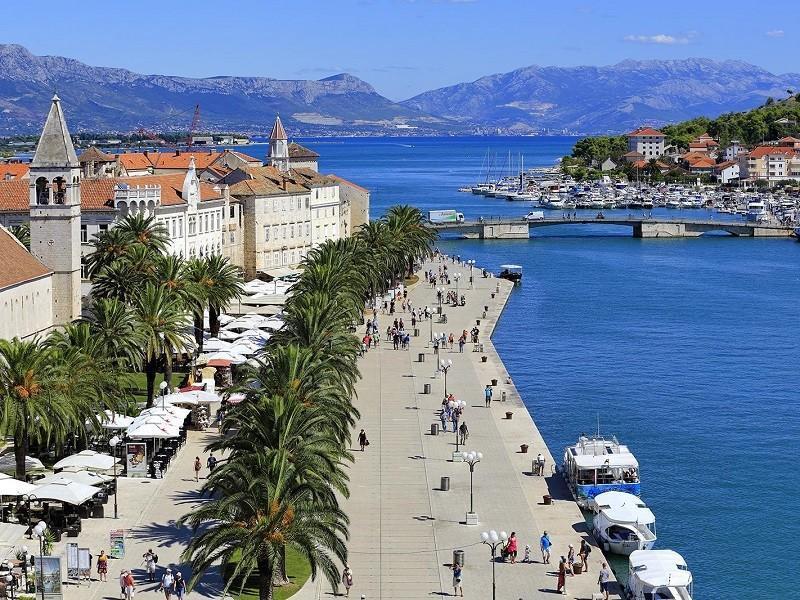
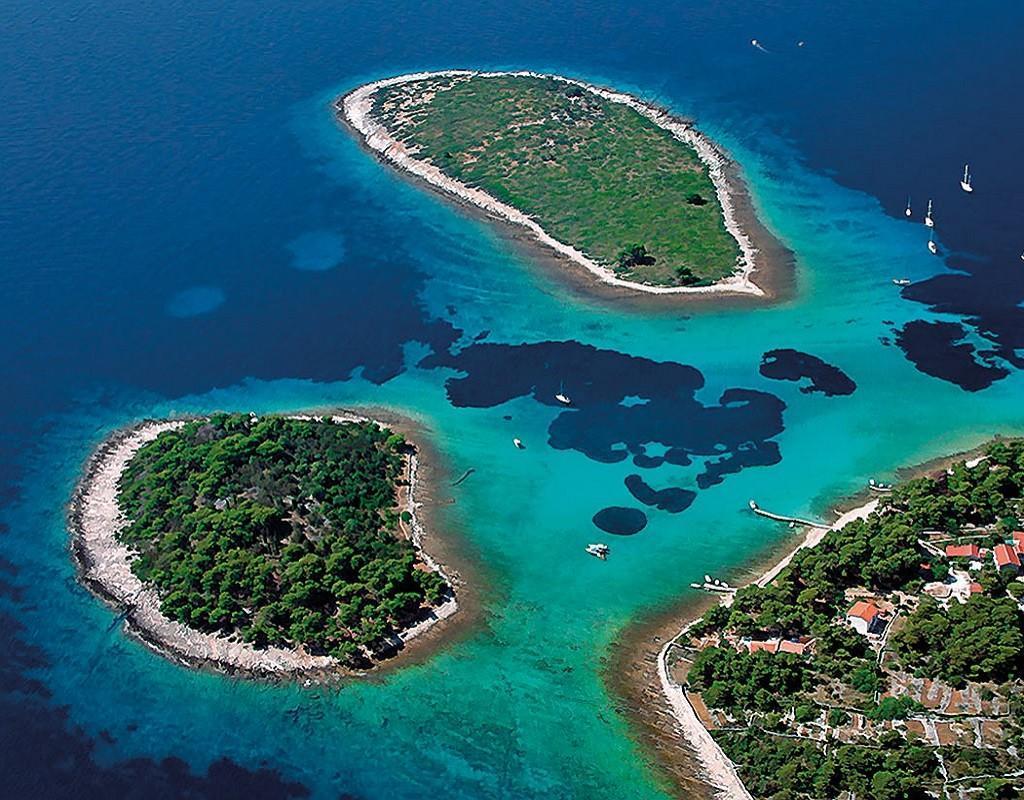
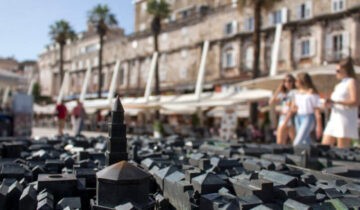
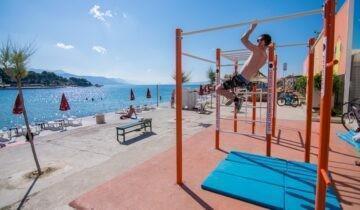
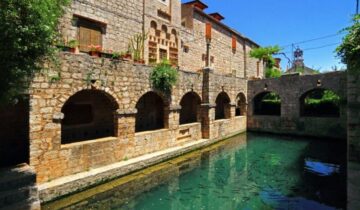
 No products in the cart.
No products in the cart.